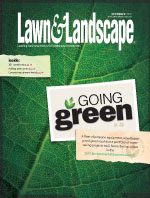 Photo: Richie Steffen/Great Plant Picks  |
This unusual conifer, with its geometric habit, looks like it was designed on a drafting table. But it’s not too rigid in appearance. On the contrary, the soft green foliage and waxy green cones give it a delightful and approachable air.
Golden larch (sometimes called false larch) has a sparse and open pyramidal frame in youth, gradually developing into a graceful open, layered tree with a broad crown.
A 10-year-old plant is about 8- to 12-feet tall and 6- to 7-feet wide. Mature specimens range from 30 to 40 feet tall with an impressive spread of 25 to 35 feet. Wild specimens are purported to grow to 120-feet-tall.
Fanciful foliage
Its flattened and soft needles appear light green on top and blue-green on the bottom in spring, turning to a bright pea-green in summer. By fall the foliage changes to bright, clear golden yellow. The needles of Pseudolarix are usually longer and broader than those of the larches.
The needles (up to 2½ inches long) appear primarily in tuft-like clusters on spur-like short shoots.
After the fall color peaks, the needles drop quickly making for easy and one-time clean up. Or the needles can be left in the bed to enrich the soil.
Give golden larch plenty of room to grow. It makes an excellent specimen tree, but a small grove of them would be spectacular.
The famous plant explorer Robert Fortune first saw this unusual conifer as a container plant in China. He introduced it into cultivation in 1854.
Culture
This easy-to-grow tree thrives in humus-rich, fertile, well-drained soil. It needs regular summer watering. Grow it in full sun or part shade because it won’t grow in full shade, and protect it from high winds.
Very little pruning is required for this slow-growing tree. Excessive pruning can easily ruin its interesting, layered, branching habit.
It may struggle in hot and humid summers, but generally performs somewhat better than the common larch (Larix decidua).
It has no serious pest or disease problems, and is hardy to USDA Hardiness Zones 5-8, though some sources claim hardiness in Zones 4 and 9. It’s synonymous with Pseudolarix kaempferi and Chrysolarix amabilis.

Explore the December 2010 Issue
Check out more from this issue and find you next story to read.
Latest from Lawn & Landscape
- Landscape Workshop acquires Cut Above Enterprises
- Scythe debuts new generation of M.52
- New identities
- Ruppert promotes Anderson to director of talent acquisition
- Fleet on the Street
- Man in the mirror
- EverSmith Brands appoints Ken Hutcheson as its new CEO
- Manitou unveils new Woodcracker tree saw with grapple





